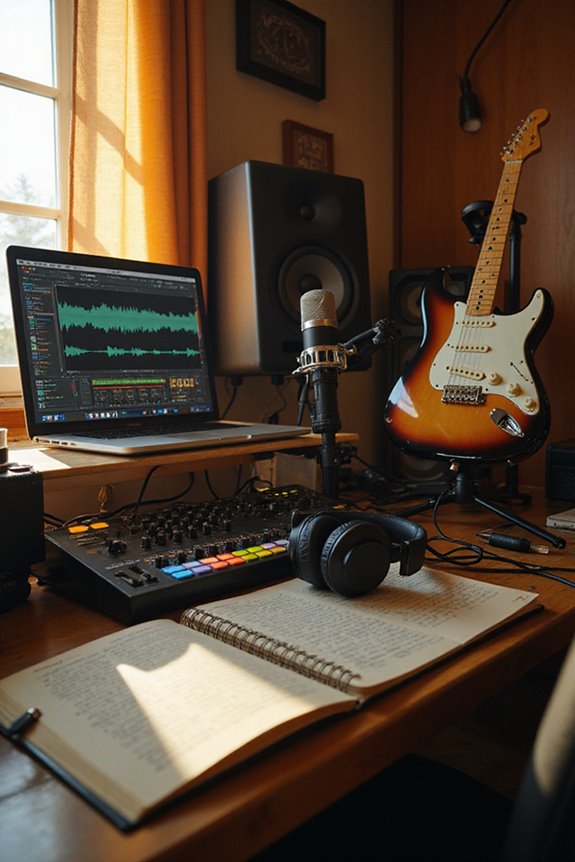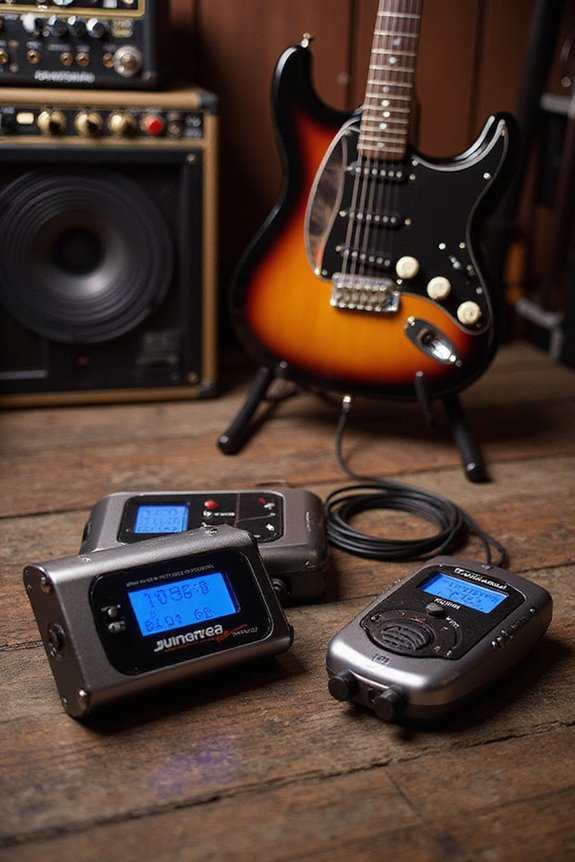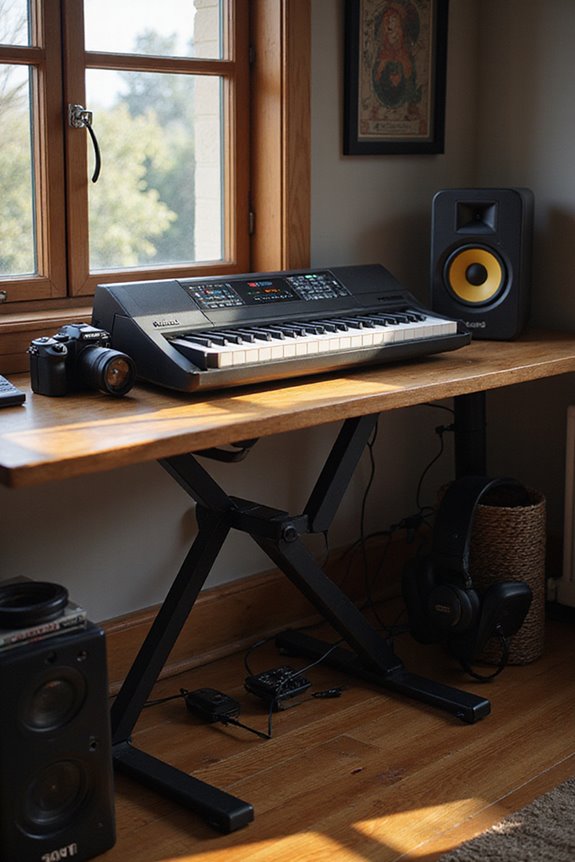When we practice guitar effectively, we establish clear, SMART goals for our progress. We should structure our sessions with focused technical exercises and combine them with enjoyable free play. It’s important to select relevant material that challenges us without overwhelming our skill level. Additionally, we can use gradual tempo adjustments to build accuracy and confidence. By balancing our practice and play time, we foster growth and creativity. There’s more to explore that will enhance our routines.
Key Takeaways
- Set SMART objectives to create clear, attainable goals for your guitar practice sessions.
- Break practice into focused 10-20 minute segments to maintain concentration and progress.
- Balance technical exercises with free play to foster creativity and prevent burnout.
- Regularly assess your skills and adjust practice material to ensure ongoing relevance and challenge.
- Use a metronome to incrementally adjust tempo, focusing on accuracy before speed.
Establishing Clear Practice Goals
When we set out to improve our guitar skills, establishing clear practice goals is essential for effective progress. By employing SMART objectives, we can create specific, measurable, achievable, relevant, and time-bound goals. For instance, instead of just wanting to “get better,” we might aim to learn a particular solo in three weeks. Using goal visualization techniques helps us envision successes, while motivational reminders keep our enthusiasm alive.
Moreover, distinguishing between short-term and long-term goals can streamline our practice. Learning a riff today leads to mastering a full setlist tomorrow. Writing our goals down not only tracks our progress but allows us to revise them as we grow. Additionally, considering included accessories in your practice plan can enhance your learning experience. Together, let’s set meaningful goals and elevate our guitar journey!
Structuring Technical Exercises
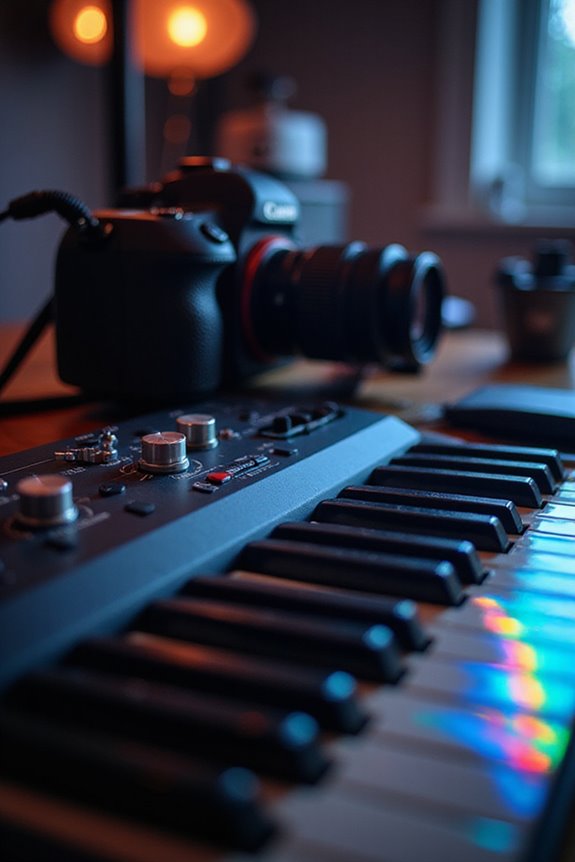
By establishing a well-structured approach to our technical exercises, we can enhance our guitar skills more effectively. First, let’s evaluate our current skill level and select appropriate exercises, focusing on areas like finger independence and alternate picking. Incorporating exercise variety is vital, so we might combine scales with different intervals or hybrid picking patterns to maintain engagement. Breaking practice into focused segments of 10 to 20 minutes helps us concentrate on specific techniques without fatigue. Gradually increasing difficulty while tracking our progress guarantees we continually challenge ourselves. By regularly reviewing our skills, we can adjust our routines to avoid plateaus, making certain our practice remains productive and motivating. Additionally, using comprehensive maintenance capabilities can ensure that our instruments are in optimal condition, allowing us to focus entirely on our practice.
Balancing Practice and Play Time
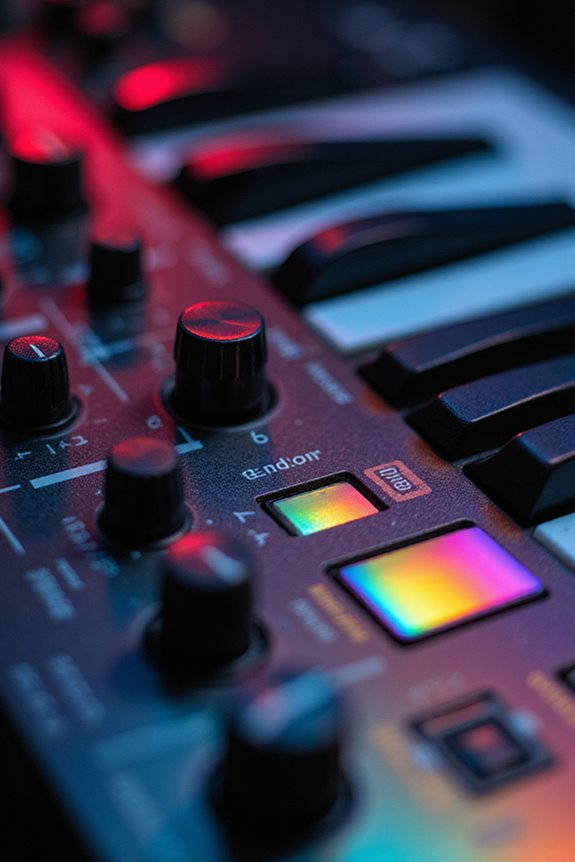
Balancing focused practice with playtime is essential for developing our guitar skills effectively. Structured sessions help us hone practice techniques, while unstructured play benefits our creativity exploration. When we integrate play into our routines, we enhance skill retention and emotional well-being, making learning more enjoyable.
By allocating specific times for technical exercises and free playing, we maximize our practice efficiency. For instance, after a focused 20-minute session, we could jam for 10 minutes, reinforcing what we’ve learned. This balance not only prevents burnout but also supports mental recovery, allowing us to come back energized. Choosing a comfortable padded guitar strap can also enhance our playing experience during practice sessions.
Ultimately, blending practice with play fosters a deeper connection to our instrument, making our musical journey both fulfilling and sustainable.
Prioritizing Relevant Material

Effective guitar practice hinges on selecting the right material for our current skill level. A proper skill assessment helps us identify gaps and choose pieces that balance challenge and achievability. For instance, if we’re struggling with vibrato, it’s wise to focus on that before diving into full solos.
We should develop a logical path through our material selection, progressing from easier techniques to more complex ones. Practicing pieces that are too advanced can lead to frustration, while regularly reassessing our skill guarantees that chosen material remains relevant. By concentrating on targeted practice and avoiding distractions, we enhance retention and growth. Let’s commit to prioritizing relevant material for sustained and effective development on our guitar journey. Additionally, considering instrument quality and materials can significantly impact our learning experience and overall sound.
Incremental Tempo Adjustments

When refining our guitar skills, adjusting tempo incrementally plays a pivotal role in our practice routines. By starting at a slow tempo, we can focus on accuracy and develop muscle memory. Using a metronome for tempo tracking guarantees our progress is objective and quantifiable, allowing us to make gradual adjustments—think small increments of 5 bpm—that match our comfort levels.
Instead of jumping to faster speeds, we should isolate difficult sections and simplify them. Breaking down these passages helps build confidence and fluency. As we gradually combine these simpler chunks, our ability to perform complex phrases at higher tempos improves considerably. This systematic approach not only enhances our playing but also makes the learning process more effective and enjoyable. Additionally, focusing on proper guitar fit can significantly impact our ability to practice efficiently and comfortably.
Avoiding Common Practice Pitfalls
While we all aim to improve our guitar skills, it is important to be aware of common pitfalls that can hinder our progress. Excessive tension can lead to fatigue and poor sound quality; let’s use minimal pressure on the fretboard to enhance clarity and endurance. We should also watch out for rhythmic neglect—balancing technical practice with rhythmic exercises is necessary for developing timing and groove. Unrealistic expectations can stop us in our tracks; setting achievable goals is essential for sustained motivation. Finally, poor handling and posture can cause discomfort and technique issues. By adopting proper positioning, we allow ourselves to practice longer and more effectively while preventing injury. Additionally, incorporating recording gear connectivity can enhance our practice by allowing us to track progress and refine our techniques. Let’s take these insights to heart and refine our practice routines!
Frequently Asked Questions
How Often Should I Change My Practice Routine?
We should reassess our practice routine every 4 to 6 weeks. If our practice frequency feels stagnant, it’s time to introduce new challenges, ensuring continuous growth and preventing disengagement with our musical journey.
What Should I Do if I Feel Frustrated While Practicing?
When frustration strikes, we’ve got to remember it’s just a bumpy road in our musical journey. Embracing a positive practice mindset and focusing on frustration management helps us find clarity and keep moving forward together.
How Do I Stay Motivated During Long Practice Sessions?
To stay motivated during long practice sessions, we can set specific goals and implement a reward system. By recognizing our progress and celebrating achievements, we turn challenges into enjoyable milestones that keep us engaged and excited.
Can I Include Songs in My Practice Routine?
Absolutely, we can include songs in our practice routine! By carefully selecting songs and integrating them alongside exercises, we enhance our skills, keep motivation high, and truly enjoy the process of learning together.
What Tools Can Help Enhance My Guitar Practice?
What tools can really enhance our guitar practice? We’ve found using a metronome for timing and chord charts for structure makes a big difference. Together, let’s embrace these tools to improve our playing!



